The Optimal Entry strategy on DailyFXplus.com has just bought USDJPY at 89.905. The system recommends entering this trade at any price between 89.758 and 90.052. The 60-period Average True Range on the 12 hour chart is 0.587, so the stop loss has been set at 89.318 and the target has been set at 90.492.

The signal was issued because our Speculative Sentiment Index was at -1.304, suggesting that the USDJPY could be trending upwards, while the price appears to be turning higher from oversold territory. The strategy looks for opportunities to buy when the Speculative Sentiment Index is below -1.22, and looks for opportunities to short when it is above +1.22.
Although US equity prices are near all-time highs, price patterns show a cluster of resistance while investor sentiment is at high levels. If these patterns are correct, then the S&P500 is at high risk of a significant sell off which could reach bear market territory of 20%.
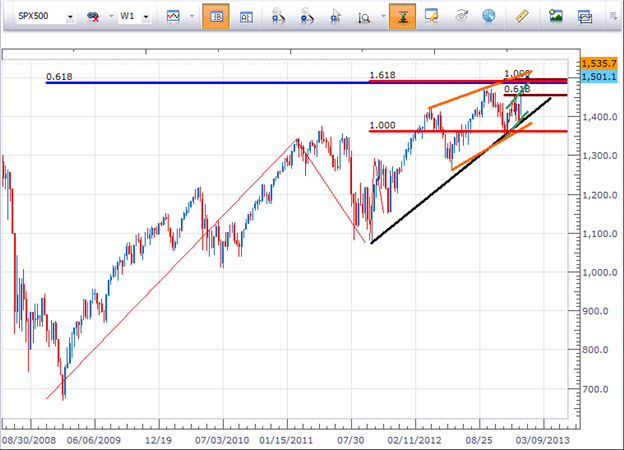
[I](Created using FXCM’s Marketscope 2.0 charts)[/I]
AUD/JPY tends to show strong correlations with the stock market. A reading close to 1.0 represents a perfect correlation. This means that if the SPX500 moves higher, then the AUDJPY tends to move higher. A reading near zero means there is no correlation between the movements of the AUDJPY and the SPX500.
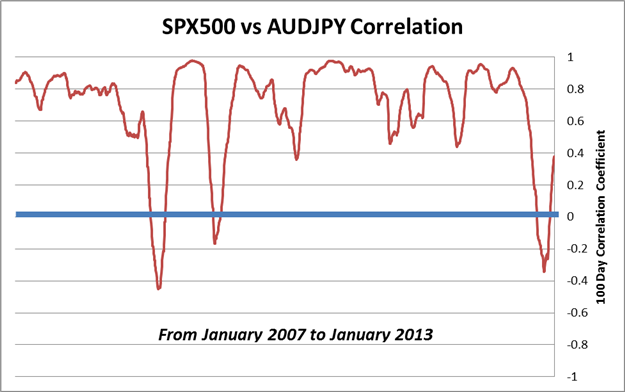
As the picture above notes, correlations don’t last forever. They move into and out of favor so we don’t want to rely on the correlation exclusively. However, we can use one part of the correlation to help us establish our longer term bias for the other.

[I](Created using FXCM’s Marketscope 2.0 charts)[/I]
Jeremy Wagner discusses how to use these correlations to identify key levels of support and resistance in his article on DailyFX.com.
Impressive forex volatility in the Japanese Yen, Australian Dollar, and Canadian Dollar continues to offer strong trading opportunities.
[B]DailyFX Forex Volatility Indices[/B]
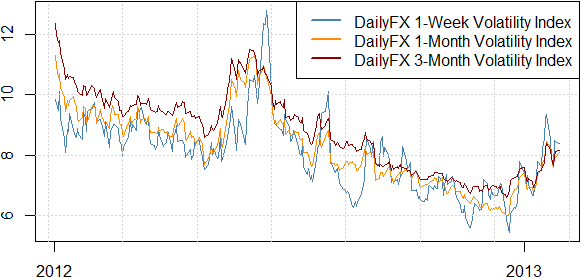
Our volatility percentiles (shown in the table below) are almost all near 100%; forex options traders predict that volatility will be the highest it has been in at least 90 days.
[B]DailyFX Individual Currency Pair Conditions and Trading Strategy Bias[/B]
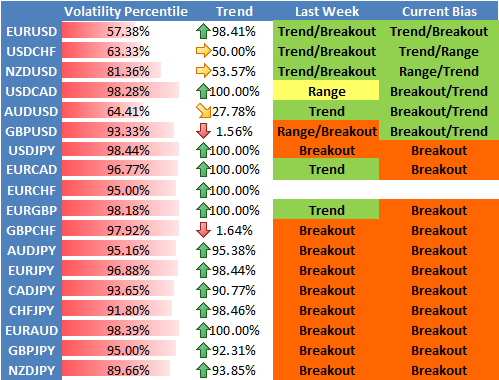
Past performance is not indicative of future results, but such highs in these options implied volatility-based indicators often coincide with outperformance in volatility-friendly strategies such as the SSI-based Breakout2 EA.
Time of release: 01/30/2013 19:15 GMT, 14:15 EST
Although the Federal Open Market Committee (FOMC) is widely expected to maintain its highly accommodative policy stance in January, the policy statement accompanying the rate decision may heighten the bullish sentiment surrounding the U.S. dollar should the central bank scale back its willingness to expand the balance sheet further.
Potential Price Targets For The Rate Decision
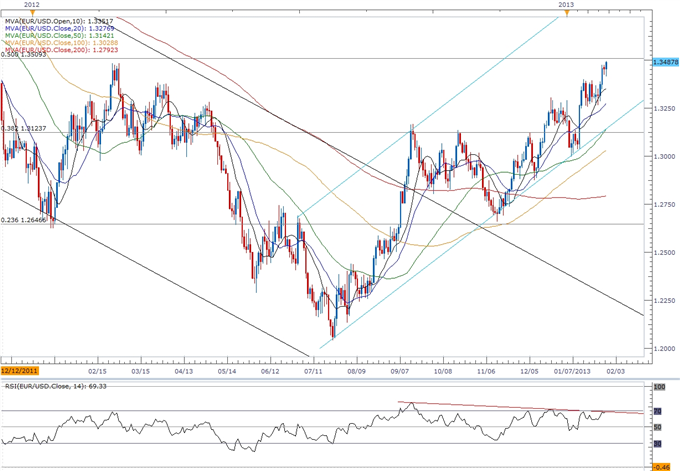
As a growing number of central bank officials take note of a more broad-based recovery in the world’s largest economy, the FOMC may strike a more neutral tone this time around, and the Fed may see scope to conclude its easing cycle in 2013 as the fundamental outlook improves.
Currency Analyst David Song provides his tips on how to trade this event risk on DailyFX.com.
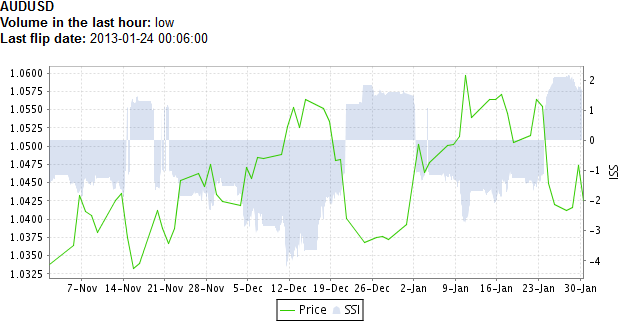
As AUD/USD tests support at 1.0400, the readings on the Speculative Sentiment Index (SSI) have flipped from short to long at 1.92. That means there are 1.92 long positions for every 1 short position. In other words, about 66% of retail traders are long.

Yesterday the ratio was 1.71; 63% of open positions were long. Long positions are 6.5% higher than yesterday and 41.1% above levels seen last week. Short positions are 5.4% lower than yesterday and 37.7% below levels seen last week. Open interest is 2.1% higher than yesterday and 2.4% above its monthly average.

We use our SSI as a contrarian indicator to price action, and the fact that the majority of traders are long gives signal that the AUDUSD may continue lower. The trading crowd has grown further net-long from yesterday but unchanged since last week. The combination of current sentiment and recent changes gives a further bearish trading bias.
Hi Coleen,
Welcome 
You might like to know that today’s SSI report on DailyFX.com agrees with you.
Weekly Summary of Forex Trader Sentiment and Changes in Positioning

Retail forex trading crowds remain heavily short EUR/USD, and a contrarian view of crowd sentiment has left us consistently in favor of further gains.
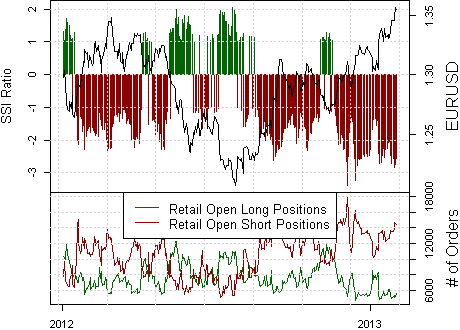
Trade Implications: An important jump in forex volatility leaves us in favor of further Euro gains, and indeed we’ll continue to favor EUR/USD longs until further notice. Our sentiment-based trading strategies have continued to buy EUR/USD.
Thumbs up, keep it going =)
Thanks, JD!
Let me know if there is a particular currency or strategy that you would like me to cover :22:
[B]Fundamental Forecast for Australian Dollar: Bearish[/B]
The spotlight is on the Reserve Bank of Australia in the week ahead as policymakers gather for their first rate-setting meeting in two months. Economists’ forecasts and investors’ priced-in expectations suggest Governor Glenn Stevens and company will hold the benchmark lending rate at 3 percent this time around. The possibility of a surprise cut seems plausible however.
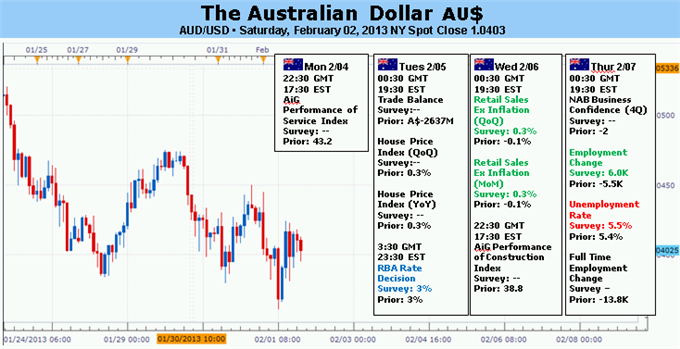
While December’s rate cut was widely expected, another reduction this time around would catch the markets off-guard and is likely to weigh heavily on the Australian Dollar. A relatively dovish statement may likewise trigger weakness if it reboots speculation about additional easing down the road.
[B]Aussie Breakdown Offers Selling Opportunities[/B]
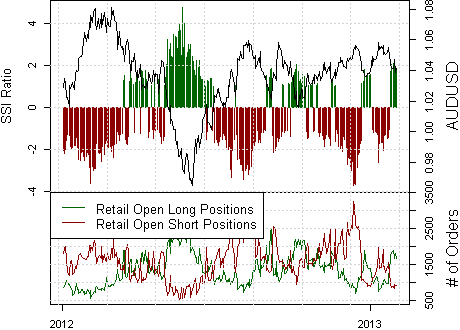
Forex trading crowds have bought aggressively into Australian Dollar weakness, and a contrarian view of crowd sentiment leaves us in favor of further declines. A close below key congestion support at $1.04 would serve as confirmation of a major break lower.

[B]Trade Implications[/B]: Our sentiment-based trading strategies have sold the Australian Dollar versus the US Dollar and Japanese Yen, but AUDUSD consolidation above $1.0400 has limited our enthusiasm for such AUD-bearish positions. We may need to see a substantive break lower to get aggressively short AUDUSD.
The Breakout Opportunities system from DailyFX PLUS has just bought EUR/JPY. The system recommends entering this trade at any price between 126.526 and 127.636. A stop loss has been set at the 24-hour low of 124.017 and a profit target has been set at the 1 Day ATR level at 128.457.

Breakout Opportunities is a breakout strategy that aims to catch the significant moves that typically happen when currencies break through technical support or resistance. The SSI-based breakout strategies tends to work well in volatile market conditions, generally when the DailyFX Volatility Percentage in a pair is above 75%.
Upcoming holidays in Hong Kong, Japan and Turkey are presenting rare opportunities to earn up to 7 days’ worth of rollover interest in just 2 days. Banks in Hong Kong will be closed next Monday, Tuesday and Wednesday. That means in addition to the normal Wednesday triple rollover that’s available for trades open at 5pm New York time today, there are 4 days’ rollover available for HKD trades that are open at 5pm this Thursday.

From the Rollover Calendar on DailyFX.com
Also, there will be 2 days’ worth of rollover on JPY trades and 3 days’ worth of rollover on TRY trades on Thursday.

The FXCM Trading Station will show you the exact amount of rollover you can earn or pay for trades open at 5pm each day. The screenshots above reflect the triple rollover amount since it’s Wednesday. That means tomorrow the rollover will be 33% higher for HKD (quadruple rollover), 33% lower for JPY (double rollover), and exactly the same for TRY (triple rollover again).
The Canadian economy is expected to add another 5.0K jobs in January and the ongoing improvement in the labor market should prop up the loonie as it raises the outlook for growth.
[B]Time of release: 02/08/2013 13:30 GMT, 08:30 EST[/B]

[U][B]Potential Price Targets For The Release[/B][/U]
As the USDCAD pivots around the 78.6% Fibonacci retracement from the 2007 low to the 2009 high around 0.9910, we should see the long-term triangle continue to take shape, and we may see a move back towards the key figure should the data highlight an improved outlook for the region.
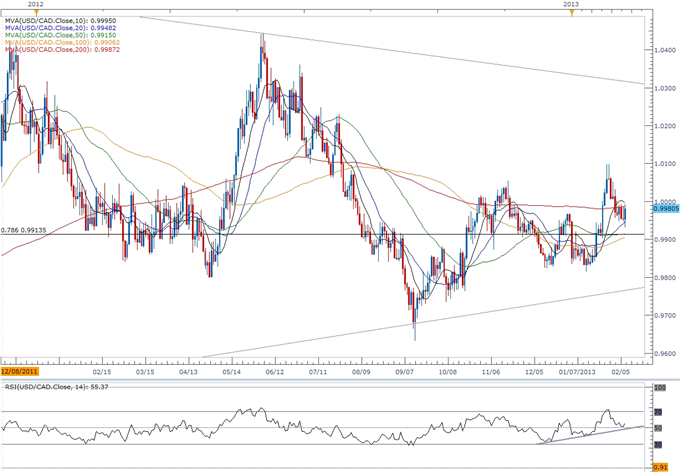
However, a dismal development should dampen the appeal of the Canadian dollar as market participants scale back bets for a rate hike, and we may see the dollar-loonie make another run at the 1.0100 figure should the employment report fall short of market expectations.
David Song provides more details on how to trade this event risk in his article on DailyFX.com.
In my last post, I mentioned that a dismal jobs number out of Canada could lead to declines in the loonie. The report released today shows that Canadian employment dropped for the first in six months in January as hiring in manufacturing and education declined.
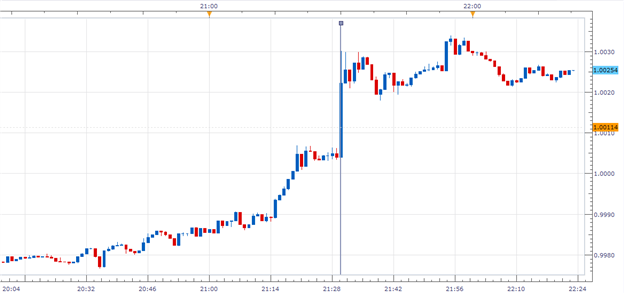
Following the data release, the US dollar jumped against its Canadian peer. As can be seen from the one-minute chart above, the USDCAD pair rallied to 1.0022 from 1.0004 and is currently trading higher at around 1.0029 and could target 1.0100 to the upside.
One of the big stories so far this year has been the steady rise in JPY crosses due to BoJ reflation. To start this week, however, DailyFX’s senior currency strategist Jamie Saettele is eyeing opportunities to short these pairs in today’s edition of Forex Trading and Technical Analysis Observations.
“[B][I]The EURJPY, CHFJPY, AUDJPY, CADJPY, and NZDJPY carved out Weekly J Spike Reversals. As such, I’d like to short early week strength in Yen crosses.[/I][/B]”
[B]EURJPY –240 Minute[/B]

Levels of interest as resistance are 12556-12606 EURJPY, 10208/45 CHFJPY, 9628/55 AUDJPY, 9325/54 CADJPY, and 7819/48 NZDJPY.
[B]AUDJPY –240 Minute[/B]
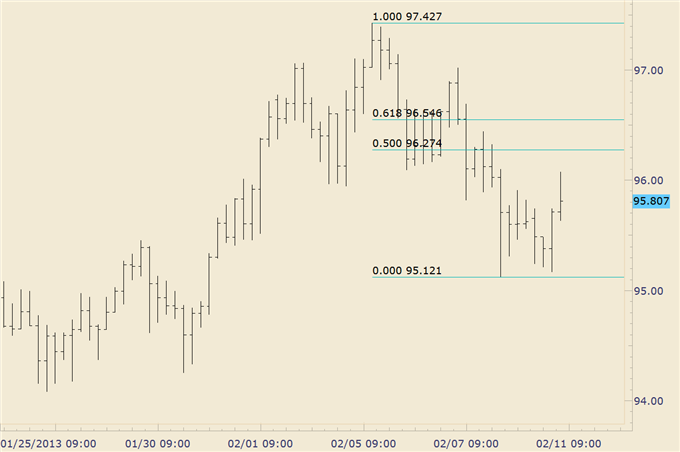
His trading will focus on EURJPY and AUDJPY but AUDJPY is probably the best play as per EURAUD structure (bullish) and AUDUSD structure (bearish).
[B]EURAUD –Daily[/B]

On that front, he’ll be looking to return to a long EURAUD position this week – he’d like to see an up day above trendline support before going back in.
In my post yesterday, I mentioned technical analysis from Jamie Saettele on DailyFX.com that pointed to a potential selloff in JPY crosses to start the week. Today, the fundamentals played nicely into this as comments from the G7 caused the Yen to surge and JPY crosses to tank.
USDJPY 1-minute Chart: February 12, 2013
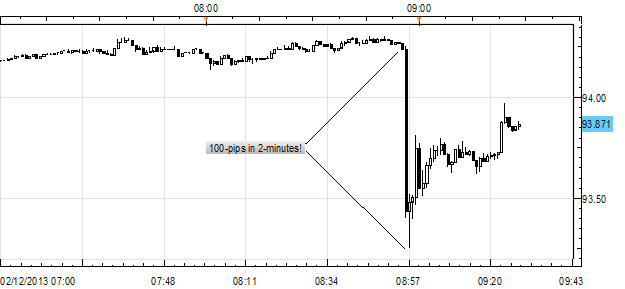
Past performance is not necessarily indicative of future results.
A G7 official said the group is concerned about the excessive weakness in the Yen, and that recent Japanese policies would be a main talking point at the G20 meeting this week in Moscow, Russia. As a result, the USD/JPY cratered, falling from 94.25 to 93.25 in the span of 2-minutes.

Past performance is not necessarily indicative of future results.
The Breakout Opportunities system just sold USD/JPY and recommends entering this trade at any price between 93.048 and 93.51, with a stop at 94.441 and a limit at 92.597. The signal was issued because the USDJPY has broken its 24-hour low while our Speculative Sentiment Index was at 1.32, suggesting that the USDJPY may have further to fall.
The euro-area is expected to contract another 0.4% in the fourth quarter, and the deepening recession may drag on the single currency as it fuels speculation for additional monetary support.
[B]Recent Economic Developments[/B]

As the economic downturn threatens price stability, European Central Bank President Mario Draghi has certainly struck a more dovish tone for monetary policy, and we may see the Governing Council push the benchmark interest rate to a fresh record-low in an effort to encourage a sustainable recovery.
[B]Potential Price Targets For The Release[/B]
We’re seeing the EURUSD struggle to push back above the 50.0% Fibonacci retracement from the 2009 high to the 2010 low around 1.3500, and the pullback from 1.3709 may turn into a larger correction should the 4Q GDP report fuel bets for another rate cut.

Indeed, the bearish break in the relative strength index favors further downside for the euro-dollar, but a better-than-expected growth print may spark a sharp rebound in the exchange rate as it raises the fundamental outlook for Europe.
David Song discusses how to trade this event risk in his article on DailyFX.com.

Forex trading crowds have bought recent Euro weakness and sold Japanese Yen strength, but a turn seems imminent based on the latest readings from the Speculative Sentiment Index (SSI).
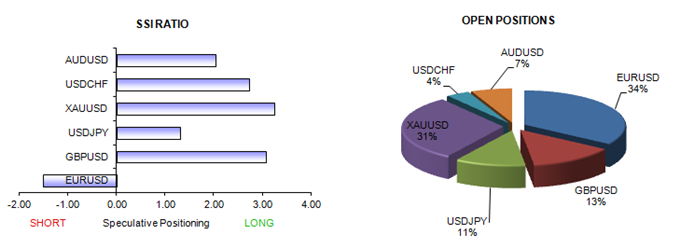
High forex volatility suggests that trend and breakout-based strategies may do well through short-term trading.

As a result, the sentiment-based trading signals on DailyFX PLUS have recently begun selling the Euro and Australian Dollar against the US Dollar and the Japanese Yen. These trading signals are available as automated strategies at FXCMapps.com.
The latest report of the Speculative Sentiment Index (SSI) included two new components: XAU/USD (which tracks gold) and SPX500 (which tracks the S&P 500).
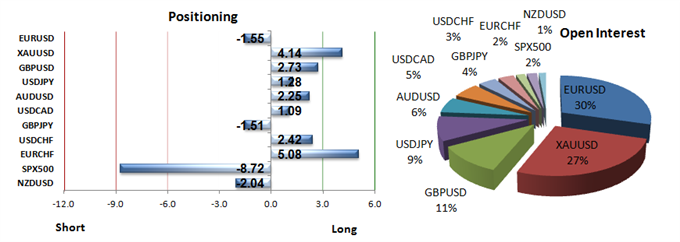
The new readings on the SPX500 were particularly interesting. The ratio of long to short positions stands at -8.72 as 10% of traders are long. Yesterday the ratio was -8.31; 11% of open positions were long. That means traders are shorting US stocks and in increasing numbers.

We use SSI as a contrarian indicator to price action, and the fact that the majority of traders are short gives a signal that the SPX500 may continue higher. The SSI report is updated twice a day at DailyFXplus.com.
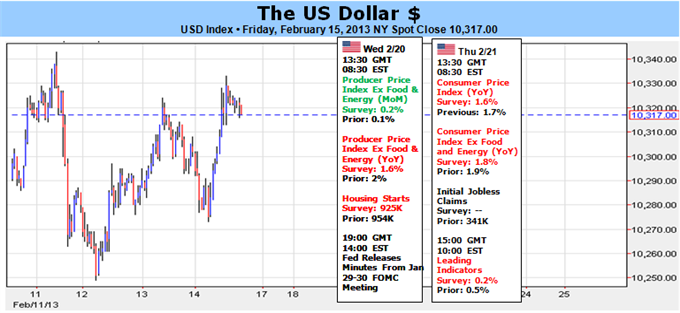
[I]Past performance is not necessarily indicative of future results.[/I]
The Dollar Index has now rallied for five consecutive weeks amidst the resurgence in FX market vols.
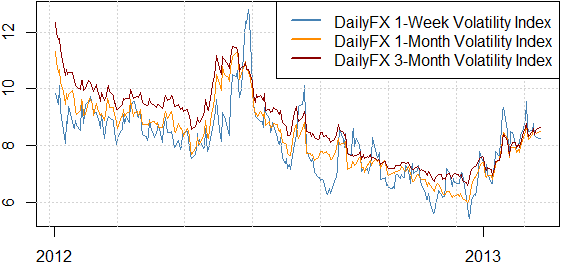
[I]Past performance is not necessarily indicative of future results.[/I]
Our DailyFX Volatility Indices continue to hit fresh highs as FX options traders bet on strong currency moves.
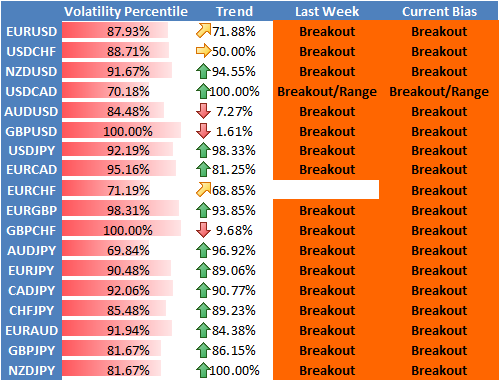
Past performance is not necessarily indicative of future results, but recent results could bode well for near-term performance across several key strategies, specifically the breakout strategies at FXCMapps.com.
Mixed signals from the G-20 regarding their stance on the weakening Yen have only fueled volatility. Many took this as a green light for Japan to continue weakening the Yen with the goal shoring up their exports, and in-turn, their economy, and a lot of the action in the markets over the past week has been Yen-driven.

While it still may be too early to tell if this will provide a long-lasting catalyst for the Yen to weaken even more against almost every known currency on the face of the planet, the recent Bull Flag put in EURJPY can spell opportunity for traders.
[B]Bull Flag in EUR/JPY highlights recent indecision[/B]

The recent concern going into the G-20 meeting, combined with the uncertainty of the next BOJ governor, the pair put in a Bull Flag formation as investors protected gains. Should the bullish momentum come back in the pair, traders can look to enter using a breakout entry order above near-term resistance to enter the position.
[B]Breakout entry offers compelling setup should Bullish trend continue[/B]
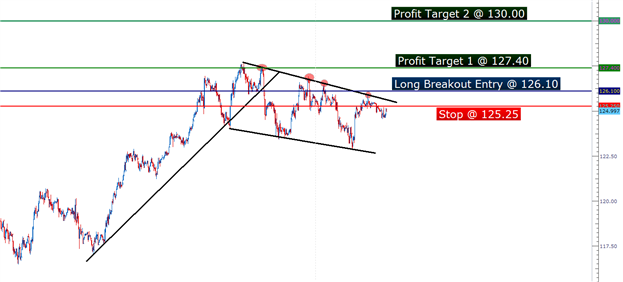
As with any other breakout entry order, risk management is of the upmost importance. The first profit target offers a 130-pip gain with 85 pips of risk, while the second profit target at 130.00 could offer as much as 390 pips to the upside. You can see more price action setups at DailyFX.com.






































